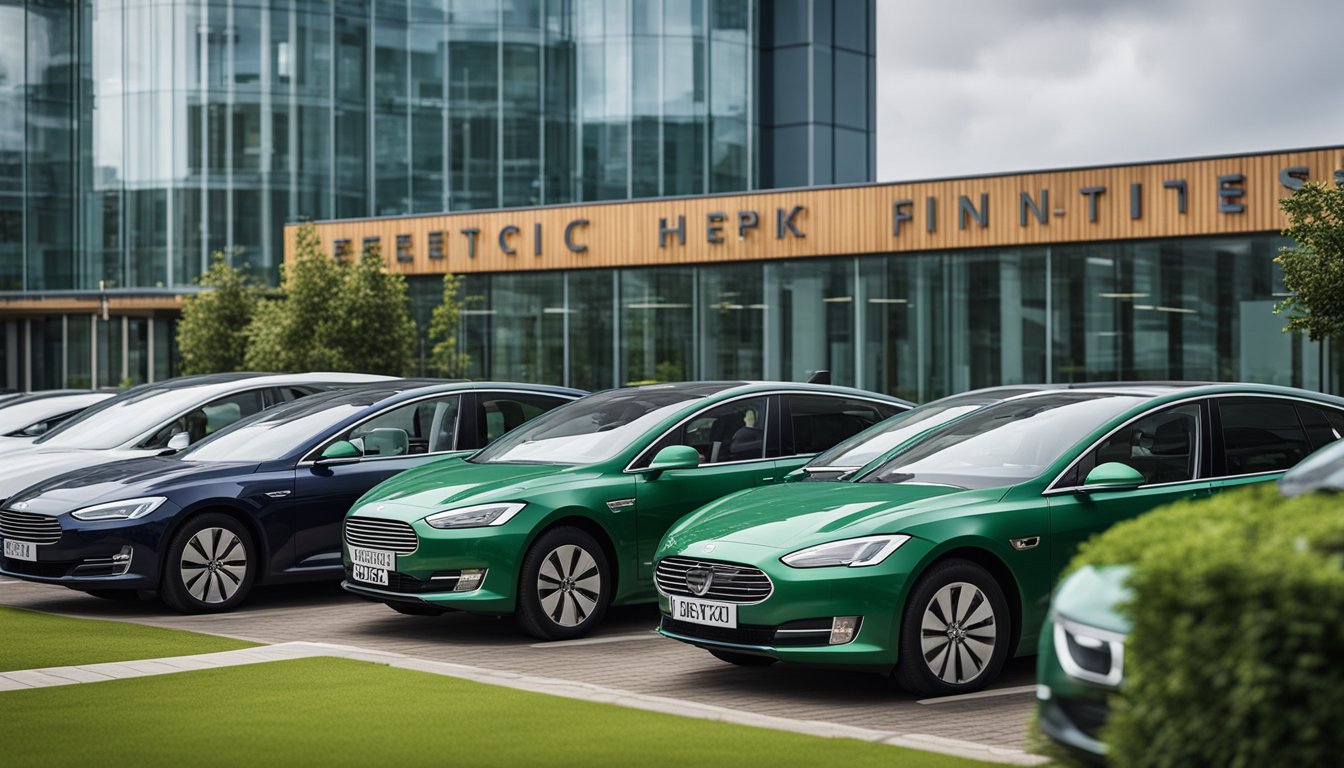Late updated: 09 Jul 2024 15:07
Written by: Amber Collins
Green Fleet Financing Options For UK Businesses: Eco-Friendly Investment Solutions
Navigating the complexities of fleet financing can be a daunting task. For UK businesses looking to adopt greener, more sustainable practices, this task becomes even more critical. With the increasing move towards electric vehicles (EVs) and other zero-emission options, securing the right financing is more vital than ever.

Our goal in this blog post is to provide a clear understanding of green fleet financing options available to UK businesses. By exploring options like contract hire, green loans, and asset finance, we aim to guide you through the choices that can help reduce carbon emissions and ultimately contribute to combating climate change.
It's essential for businesses—especially SMEs—to identify the most viable financing strategy. Whether you're looking to upgrade your current fleet to meet CAZ compliance or aiming to completely overhaul your fleet with state-of-the-art EVs, the right financial solutions are out there. We’ll dive into these options and provide tactical insights to help your business make its green transition smoothly.
Key Takeaways
- Green fleet financing can significantly help UK businesses move towards sustainability.
- Various financing options are available, including green loans and contract hire.
- Choosing the right strategy can reduce emissions and support climate initiatives.
Understanding Green Fleet Financing
Green fleet financing offers a way for UK businesses to transition to more environmentally friendly vehicles while managing costs effectively. Key considerations include choosing the right funding options and evaluating their impact on cash flow and VAT.
Funding Green Assets
Businesses can fund green assets such as electric vehicles (EVs) and hybrid vehicles through various financial mechanisms. Bank loans are a viable option with borrowing amounts starting at £50,001 up to £10 million at fixed rates.
NatWest Green Loans specifically cater to funding green assets for businesses aiming for net-zero transformations.
Grants and subsidies may also be available from government schemes incentivising the adoption of renewable energy and sustainable transport solutions.
Ownership Vs Leasing
When acquiring green fleets, businesses face the choice between ownership and leasing. Outright purchase provides full ownership of the asset, allowing businesses to capitalise the vehicle and reflect it as an asset on their balance sheet.
Finance leases and hire purchase agreements spread the cost over time but typically have higher monthly payments compared to operational leases.
Operational leases or contract hire agreements offer lower monthly payments by factoring in the residual value of the vehicle. This type of leasing is beneficial for businesses that renew their fleet regularly or avoid the risks associated with asset depreciation.
Impact of Financing on Cash Flow and VAT
Green fleet financing impacts a business's cash flow and VAT obligations. Financing options like hire purchase allow businesses to spread capital expenditure over a period, easing immediate cash flow pressures.
Operating leases and contract hire agreements often have lower upfront costs, helping to manage cash flow more effectively.
VAT treatment varies by financing option. With outright purchase, VAT is paid upfront. Leasing arrangements often allow VAT to be spread over the lease term, thereby smoothing out cash flow impacts.
Proper accounting for VAT on financed green assets ensures compliance and can impact overall financial health, making it critical to consult with tax professionals to align financing strategies with business goals.
Tactical Insights for Fleet Financing

In fleet financing, assessing providers, adapting to regulations and incentives, and prioritising sustainability are crucial for operational success. Here are key strategies and considerations for efficient fleet financing.
Evaluating Fleet Financing Providers
When selecting a fleet financing provider, it's important to look at their offerings comprehensively. We should consider finance leasing, operating leasing, and contract hire options.
Review the terms of each option: finance leasing often involves long-term commitments, suitable for stable fleets; operating leases, especially contract hire, offer flexibility with typically lower rentals, reflecting the asset's end-of-term value.
Financial stability and the provider’s market reputation are critical. Providers like DLL offer financing for sustainable solutions, helping businesses achieve both economic and environmental goals. Engage providers who offer tailored solutions and precise cost-benefit analyses.
Navigating Regulations and Incentives
Navigating the regulatory landscape is essential. In the UK, fleet regulations might include emissions standards and safety requirements. The availability of government incentives for low-emission vehicles can significantly impact financing decisions.
We should stay updated on local and national environmental policies. For example, implementing fleet emission strategies is not only regulatory compliance but ensures non-monetary benefits such as improved company image and duty of care fulfilment.
Exploring incentives like grants, tax reliefs, and subsidies for electric and low-emission vehicles can reduce upfront costs substantially. By aligning fleet acquisitions with these incentives, we optimise both compliance and cost-efficiency.
Maintaining Fleet Value and Sustainability
Maintaining fleet value requires strategic planning from acquisition through to disposal. Selecting vehicles with higher residual values can minimise depreciation costs. Regular maintenance and timely upgrades should be part of our strategy.
Sustainability is also key. Investing in reduced emission vehicles not only aligns with greener agendas but can generate long-term savings. Studies suggest savings of 10%-30% over the lifetime of an electric HGV. Sustainable transport solutions should be integrated into fleet management policies.
We must balance cost considerations with sustainability goals. Periodic evaluations and adopting practices from leading fleet management companies can assist in keeping our fleet economically and environmentally efficient.
Frequently Asked Questions

In this section, we address key questions about the criteria, support, tax implications, financing options, lenders, and application processes for UK businesses looking to transition to a green fleet.
What are the eligibility criteria for UK businesses seeking green fleet financing?
Eligibility criteria can vary between lenders. Generally, businesses should demonstrate their commitment to reducing their carbon footprint, have a clear plan for fleet usage, and be financially viable. Some lenders may also look for compliance with certain environmental standards or certifications.
How does the UK government support financing for eco-friendly business vehicles?
The UK government offers several incentives. These include grants for purchasing electric vehicles, tax breaks, and funding programs aimed at aiding businesses in adopting green technologies. Additionally, there may be specific schemes that vary by region or the type of vehicle being financed.
What are the tax implications for UK businesses opting for green vehicle finance?
Businesses can benefit from various tax advantages such as lower Vehicle Excise Duty for electric vehicles. Capital allowances may also apply, allowing businesses to deduct a portion of the vehicle cost from their taxable profits. Furthermore, there are potential savings on Benefit-in-Kind tax for employees using company electric cars.
What types of financing options are available to small businesses in the UK for environmentally friendly fleets?
Small businesses can choose from various financing options. These include green loans specifically tailored for electric vehicles, leasing options that spread the cost over time, and asset finance which uses the vehicle as collateral. Each option has its own terms, so it's important to compare them based on business needs.
Are there specific lenders in the UK that offer competitive rates for green fleet acquisition?
Yes, several UK lenders provide competitive rates for green fleet financing. Institutions like NatWest offer Green Loans, which are designed to fund eco-friendly assets. Other lenders may have similar products, often with favourable terms to encourage the transition to green fleets. Comparing rates and terms is advisable.
How can businesses in the UK apply for financing to transition to a green fleet?
Applying for green fleet financing typically involves a few key steps. First, identify and compare financing options from various lenders. Next, gather necessary documents, including financial statements and your green fleet plan. Finally, submit your application to the chosen lender, ensuring all criteria are met and required information is provided.
